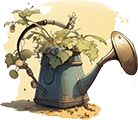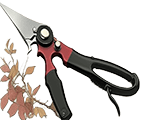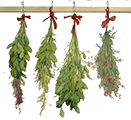
Florida’s climate presents unique growing conditions for herbs…
![]()
*Excerpts from ‘Growing Herbs in Florida’s Climate’ …class offered by James Steele 1990-2010 – The Herb Garden
Introduction…
I have been growing herbs in Florida since 1970, over 46 years as of this writing, and have come to understand some of the particular areas where our Florida climate influences my herb gardening practices. Florida has a unique climate. As a southern peninsula, surrounded on three sides by water, we experience some challenges to herb growing due to the longer growing season, milder winters, rain, and humidity.
Herbs enjoy cool nights, low humidity, plenty of sunlight, well-drained, slightly alkaline soil, and proper watering. There are always exceptions to the rule but these are the basics for a wide variety of herbs. With herbs doing well in these conditions, here in North Central Florida, late Fall, Winter, and early Spring provide great weather for growing herbs, with Summer being the greatest challenge. -James
![]()
 Sunlight
Sunlight
Herbs contain a wide range of oils and are effective medicinally and flavorful in cooking. For this reason, in order to obtain good oil production, herbs need at least 4-5 hours daily. We have no shortage of sunshine in Florida( hence, The Sunshine State ) and, generally speaking, most herbs do quite well. On the contrary, when the summer sun moves across the sky hour after hour, it is often too much for some herbs. Chlorophyll gets bleached by intense sunlight resulting in the leaves fading to a pale green. With this in mind, make use of other plantings for overhead relief and containers that are easily moved when the sun is too intense. You may find ‘Partial Shade’ a welcome alternative.
![]()
![]()
 Temperature
Temperature
Herbs can handle a wide temperature range. Many are quite cold-tolerant while others are able to handle our hottest Florida days. One issue that Florida’s climate presents in growing herbs, is the wide temperature fluctuations, especially in winter. While the average day/night temperature range here at The Cove is 20°, a sunny Florida winter day that is 75° can turn a cold 35° by night! These wide fluctuations put some stress on plants as well as mess with their metabolism. Things to regulate the temperature of our herb gardens are mulching, creating wind blocks, and overhead vegetation. All help to keep a more temperature-balanced environment.
![]()
![]()
 Soil
Soil
Soil plays a very important role in your herb garden by acting, not only as a stabilizer for your plant but as a reservoir for water and dissolved fertilizer and, like your children or pets, needs nourishment to keep it thriving. Healthy soil is made up of:
- 45% mineral
- 25% air
- 25% water
- 5% organic material
It contains an abundance of bacteria and organisms that are constantly working to break down natural organic matter and fertilizers making them available, in solution, to your herbs.
Florida soils are a whole other creature. On one end we have clay…flat particles that stick up on one another forming a dense soil that is prone to holding too much water and on the other end we have Florida sand, either coarse or fine, the course with little water holding capacity and the fine that has water flowing along the top and running off. In the middle we have what is often classified as loam…a balanced combination of clay, sand, and organic matter…this is what we are looking for, often referred to as a well-drained, sandy loam.
Herbs like dry feet. They do not like wet soil and if too wet, the roots will rot. Clay soils often are too wet for herbs unless amended with sand and organic matter to allow drainage. What often happens with the flat clay particles, is they divert water and dissolved nutrients laterally away from roots rather than downward toward the roots. Coarse sandy soils, on the other hand, have very little organic matter and larger air pockets where water, and dissolved nutrients, often flow down too quickly resulting in the leaching of valuable nutrients. Our well-drained sandy loam allows water and dissolved nutrients to enter the root zone, get trapped in the air pockets and organic matter long enough for absorption by the roots, and take up to the herb. Eventually, this solution will either be taken up by the herb or with gravity be pulled lower and eventually out of use*…this process is what well-drained soil refers to.
* Through conductivity, water that eventually starts its downward progress into the soil, will attract the roots as well thus leaving you with a well-rooted plant, better protected from drier, hotter, Florida soil conditions. The Water-Fertilizer-Soil relationship is very important!
Florida’s sun can heat soil well over 100° F, literally cooking bacteria, and shallow roots and evaporating any available soil moisture. Mulching your herbs, with at least 4 ” of material creates a protective blanket between Florida’s hot drying sun and the well-drained soil preventing this drying. In the Cove Garden, we use hay and straw as our mulch, because it provides a nice airy blanket that eventually breaks down and is incorporated into the soil as well.
![]()
![]()
 Fertilizing Herbs
Fertilizing Herbs
If we look at nature, we see the fertilizer and water cycle evident through the seasons. During the warmer rainy months, bacteria in the soil are active, breaking down nutrients that dissolve in rainwater. During the colder drier months, bacteria slow down, nutrients are less available due to lack of moisture, and plant and tree growth are greatly reduced. Many deciduous trees drop their leaves to maintain as much water in their system until warmer weather and rain once again make nutrients available.
We have more control of this cycle in our gardens, as we can fertilize and water on an as-needed basis, and, herbs will continue to grow as long as there are nutrients available for them. Over the years of teaching classes on growing herbs, It surprises me the number of folks who
- didn’t realize you had to add extra fertilizer, thinking nature and the ground provided it and
- never knew the relationship between water and nutrient availability.
Let’s take a look at these two situations…
All plants need 17 nutrients for optimal growth and these are…
Macronutrients derived from air and water:
- Carbon (C)
- Hydrogen (H)
- Oxygen (O)
The Primary Macronutrients:
- Nitrogen (N): Green Leafy Growth
- Phosphorus (P): Development of roots, flowers, seeds, and fruit;
- Potassium (K): Strong stem growth, Disease Resistance, promotion of flowering and fruiting;
These are the three numbers you see on fertilizer packages like 10-10-10. These three macronutrients are used by plants in the largest quantities.
Three secondary Macronutrients:
- Calcium (Ca)
- Magnesium (Mg)
- Sulfur (S)
The Micronutrients:
- Iron (Fe)
- Boron (B)
- Manganese (Mn)
- Molybdenum (Mo)
- Zinc (Zn)
- Copper (Cu)
- Chlorine (Cl)
- Nickel (Ni
Herbs are naturally fast growers, they seem to double before our eyes and benefit from small amounts of fertilizers, preferably natural, organic fertilizers…
- Nitrogen – Cottonseed Meal, Blood Meal, Fish Emulsion, Manures, Compost and Worm Castings
- Phosphorus – Bone Meal, Dolomite Phosphate Rock
- Potassium (Potash) – Sulfur of Potash, Wood Ashes, Manure, Greensand
These natural fertilizers are complex molecules and take longer to break down becoming available to the herb over a steady and longer period of time, allowing the herb to spend energy producing oils instead of leaf growth which happens quickly anyway.
Synthetic fertilizers such as Peters or Miracle Grow are adequate for some other types of plants, however, they dissolve and are readily available and used by the herb instantly creating fast green growth over the expense of producing oils. They also do not add anything to the soil in terms of bacteria and soil complexity.
Now if you are growing herbs in containers, the dynamics change a bit. Often an herb will outgrow a container quicker than the full benefit of a natural fertilizer will break down. Also, the root area is not as insulated as it is in the ground and will dry out more quickly, thus requiring more watering. In this case, I often used an encapsulated fertilizer like Osmocote or another similar product, that releases a small amount of fertilizer when watered.
![]()
![]()
 Watering Herbs
Watering Herbs
Water is the key ingredient that is essential to living, fertile soil. It is necessary to dissolve the broken-down fertilizer into a solution for the plant to uptake and provides structure to the soft-branched herbs.
Plants are hollow…like straws…inside the branches and trunk are tubes going from the roots to the leaves. There are openings in the roots that allow the dissolved fertilizer/water solution to move up into the plant and there are holes in the leaves that also intake moisture on the leaves as well as being the exit point for water going through the plant. Unlike a hard-barked plant, herbaceous herbs keep their form with water in these tubes. When there is not adequate water, wilting occurs. The process of water flowing through a plant is Transpiration.
Understanding transpiration will give you a better understanding of which herbs prefer more water or less water. Take Rosemary, Sage, Lavender, and Thyme as an example. These herbs have very oily, fragrant, small leaves. Being small or thin-leaved lets us know there are not as many holes in the leaves for water to exit ( Transpiration )…on top of that add oil that is covering these holes and we have herbs that prefer dry conditions or else they struggle. When Florida’s rainy season hits, accompanied by the heat and humidity, these herbs do not need much watering. These herbs get an attitude when July and August come along here in Florida! On the other hand, larger leaved herbs like basil, root beer plant, catnip, etc have more leaf surface, thus more holes to lose water and will require additional water at times.
In Florida we have very humid summers, meaning there is a lot of moisture in the air. This moisture actually slows down the transpiration rate as compared to the winter. You may find that on a breezy winter day herbs will wilt faster than on a humid summer day.
When watering, it is good to apply water as close to the roots of herbs where it is most needed. Drip hoses do this well, as do watering cans. The idea is to water the soil not the plant and to water as long as possible to make sure water travels deep into the root ball and ‘invites’ the roots to go deeper into the soil. The benefit of this is an herb less prone to wilting during dry times…the deeper roots stay cooler and just a bit more moist. The roots will stay wherever the water and dissolved fertilizer is, so, quick shallow watering trains the root to remain near the surface, thus subject to heat and cold injury while at the same time training you to water more often. Overhead watering is not only inefficient, but it creates another layer of moisture, on top of Florida’s already high humidity inviting problems for your herbs.
![]()
![]()
 Propagating Herbs
Propagating Herbs
Propagating herbs is quite easy. There are three common ways to propagate herbs…from seed, from the stem and root cuttings, and from division. I usually use a rule of thumb that has worked for me over the years. I start my annual herbs, ie; Basil, Cilantro, Dill, and Chamomile, etc. from seed. Most annual herbs produce a lot of seeds and they germinate quite quickly. I start my perennial herbs, ie; Comfrey, Lavender, Rosemary, Mint, and Oregano, etc. from stem/root cuttings and division. Perennial herb seed usually takes much longer to germinate and can often produce variances of the same species. Propagating from cuttings will ensure that the new plant will be an exact clone of the original.
Types of Propagation:
Seeds: When propagating from seed the medium used will need to hold water to remain damp but not over-saturated. The dampness will break down the outer seed coating and promote germination. Fine potting soil is often used for this purpose. A rule of thumb to remember when sowing herb seeds is to sow the seed no deeper than the widest part of the seed. This is important, as many herb seeds are very small, almost dust-like as in Chamomile, and need only be broadcasted on the surface allowing the water to wash it into place. Nasturtiums on the other hand are larger and are placed at a depth that matches the size of the seed. Keep the medium damp and results will be seen often within a matter of days to a week.
Cuttings: Propagating herbs from cuttings is easy as well and requires just a few things to remember. Herbs root very quickly, often in a matter of a week, depending on soil dampness, temperature, and sunlight. Cuttings are usually taken from the upper tips of the branches, either where the stem is totally herbaceous or where the stem transitions to a little stronger consistency. Each cutting should have at least one or two nodes…areas, where either leaves and branches form or roots, may form. Make sure at least one of these nodes is below the soil surface. (Note – Some herbs will root anywhere along the stem, but it is good practice to have some nodes present ).
Cuttings need a well-drained but damp medium. Sunlight keeps the herb cutting viable while in the rooting process. Do not cover your cuttings with a dome as is often done for other types of plants. Herbs do not like moisture around their leaves and too much humidity can cause rotting before rooting. Check the cuttings daily to ensure the soil is damp and it is safe to check for roots after the first week, which when rooted, can be transferred to another container.
Division: Another way to propagate herbs is by division, separating clumps into pots or plants and it is easy to do. I regularly use this method for Aloe, Chives, Garlic Chives, Roman Chamomile, and Yarrow. Division is merely separating ‘pups’ like in Aloe, Yarrow, and Roman Chamomile or clumps as in Chives. Herbs are tough, don’t be afraid to cut apart a large clump of Chives and replant.
![]()
![]()
 Pruning Herbs
Pruning Herbs
Pruning is essential to harvesting your herbs as well as shaping their growth and maintaining the health of your herbs. Herbs respond quickly to pruning producing thick luscious plants. Let’s take a look a what pruning is…
Herb stems each has a tip, or top, called the apical meristem. This stem tip is dominant and proceeds to grow quickly while all the nodes below it only produce leaves and smaller stems that do not outgrow the apical meristem. This is because the meristem produces a class of hormones called Auxins that regulate the growth of the plant. While the meristem is growing up and out, auxins travel down the stem and prevent the lower leaves and stems from overtaking the apical meristem. Pruning interrupts this process.
We prune our herbs because we want to use them and enjoy their flavors and we may prune to shape our herbs. When we prune, we are cutting off the apical meristems, thus cutting off the flow of auxins to the lower stem. The result is all along the lower stem, leaves and branches begin growing, thus giving us a thicker herb plant. Eventually, these new stems will have their own apical meristem, and the process repeats.
Some points to know about pruning…
- When possible, prune above a node, not below a node. When pruning below a node, the stem left will die down to the next node and will require removal to prevent the spread of disease that may form in the decaying stem. Now, this is easy to do on many herbs but sometimes it is difficult as in pruning Thyme, and because the nodes are so close together it does not present a problem.
- Try not to prune more than a third of the plant. Leaving two-thirds still allows the plant an adequate amount of leaves for photosynthesis and keeps the plant healthy. Some plants may be pruned severely, even to the soil level, as in the case of mint, however, when doing this it is extremely important to reduce watering that plant until new leaves begin to emerge.
- The timing of pruning is critical when it comes to certain herbs. Herbs like low humidity conditions and we know from the previous section on watering that water exits from a plant through the leaves by transpiration. In a month like August, for instance, we have a lot of rainfall and high humidity, two conditions that cause problems for oily, thin, or small-leaved herbs like Thyme, Rosemary, Sage, and Lavender. As mentioned in the section on watering, because of the thin, small, and oily leaves transpiration is a very slow process so pruning these herbs too much in the hot rainy months, removes very necessary leaves and could lead to problems. Prune sparingly.
![]()
![]()
 Insects & Diseases
Insects & Diseases
Prevention is the key to healthy herbs. While they will never be insect-free or disease-free, keeping conditions right for a healthy herb goes a long way to preventing problems. A weak plant is an invitation for insects and diseases to take control. Cover the basics when planting herbs… well-drained loamy soil, adequate water and nutrition, proper sunlight, and proper spacing for airflow.
Circulation: Air flow is often overlooked and many herbs are placed much too close together cutting off sunlight and air, often leading to wet decaying leaves and fungus. Remove dead leaves and prune away dead stems often.
Watering: Improper water is a key reason for inviting the onset of diseases and insect attacks. Wet soil and wet leaves are two things sure to bring down your herbs. Avoid watering late in the evening. Water with enough time left in the day for the leaves to dry out before night arrives. Cool, dark, wet leaves are sure to invite a fungus. Make sure your soil drains well and does not remain too wet for long periods.
Insects will surely find a weak plant, however, even a healthy plant can, and will be, attacked. Whiteflies, Leaf miners, Spider Mites, Aphids, and Slugs are some of the main critters that will visit your herbs. If they are on a large scale, it is usually because the plant is weak due to one of the problems mentioned above. Horticultural Soaps, Neem Oil, and even home remedies like Dish soap and oil will often correct minor occurrences. In a healthy, well-planned herb garden, beneficial insects will usually keep the unwanted invaders in check…prevention is the key.
![]()
![]()
 Drying and Storing Herbs
Drying and Storing Herbs
We dry and store a lot of our herbs here at the homestead. Drying herbs keep them free from bacteria and fungus and when stored well provide good flavor for the entire season.
Drying herbs require good air circulation and a little warmth also helps. In the previous section on watering, I discussed transpiration and the fact that water flows out of tiny holes in the leaves. This is true when drying…to remove water air circulation needs to pass over the leaf surface to draw the water out.
We pick our herbs when dry but not before the afternoon sun heats up the oils, usually late morning. After clipping off any old dried leaves or stems the herbs are ready. While there are several ways to dry herbs, we usually use the indoor air drying method or, depending on the herb, a multi-level dehydrator. When air drying we do not bunch our herbs and hang them up as this doesn’t allow good air circulation in the bunched area and can lead to improper drying. We usually hang our herbs on a string line, the herbs held on the line by their own stem either bent over or if a multi-stemmed plant, one of the stems. We have the drying line under a ceiling fan, turned on medium, which provides adequate air movement. Within a matter of a couple of days, this slow-drying method captures the oils and flavors and gives us excellent results. It is good to place some of these dried herbs in a plastic bag a look to see if moisture forms. If so they will need more drying time.
Our herbs are stored in canning jars and kept in our herb hutch where it is cool and dark and used as needed.
How we preserve some herbs:
- Pick Bay Leaves fresh and put them directly into a freezer bag, store in the freezer, and use as needed, Tarragon is also done this way.
- When making Pesto with Basil, keep some in the fridge, and some in ice-cube trays in the freezer.
- We dehydrate Datil Peppers, then combine them with Kosher salt crushing them into a spicy salt mix
- We often infuse Oregano and Rosemary in Olive Oil and Garlic and store them in the fridge if not used within 6 months, which is rare here at the Cove.
Remember that dried herbs are more concentrated than fresh so you need less in recipes. I combine fresh with dried when cooking because the fresh still do have a few oils that are lost when drying. Checked your dried herbs occasionally. They should retain their color and fragrance if stored properly…be sure to label them. Enjoy
![]()
![]()


